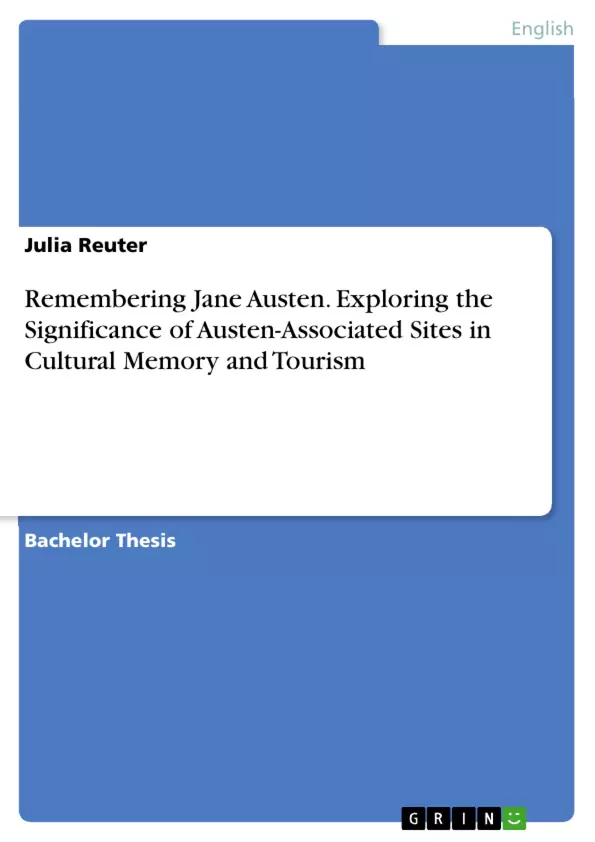This paper focuses on the physical sites which are associated with Jane Austen: the places where she lived and a selection of locations which appear in film adaptations of her novels. Both types attract thousands of visitors from all over the world each year. This leads to some of the following questions: Why do people feel the need to follow in her footsteps? Do they require these physical places in order to remember her? And considering the fact that the locations in question are now part of the tourism industry, how much do they actually still have to do with Jane Austen?
In cultural studies, memory is one of the most frequently discussed issues. In the last twenty years alone, there have been numerous publications on the subject. Inspired by the seminal work of Maurice Halbwachs (1877-1945), who was one of the first scholars to regard memory as a social phenomenon, Jan Assmann developed his theory of the ‘cultural memory’ in 1988. Pierre Nora’s concept of the lieux de mémoire, begun in 1984, continues to draw a great deal of attention in academic circles as well.
It is the aim of this paper to shed some light on the role the Jane Austen locations play in remembering her. In order to gain an understanding of this issue, certain aspects of Halbwachs’, Nora’s and Assmann’s theories will be connected to Jane Austen tourism. A short summary of their ideas can be found in chapter 2. The criteria by which the locations will be evaluated are listed in chapter 3. Chapter 4 contains an analysis of some of the most prominent Jane Austen-themed locations in contemporary England, including their relevance to Jane Austen’s life. The first part concentrates on places where she actually lived and where she stayed for longer periods of time. These are arranged in chronological order and followed by an analysis of several memorable film locations. In chapter 5, theory and practice will be joined in order to find answers to the questions previously asked. Finally, the paper ends with an overview of the relevant points.
Inhaltsverzeichnis (Table of Contents)
- Introduction
- Theoretical Concepts of Memory
- Maurice Halbwachs: La Mémoire collective
- Pierre Nora: Les Lieux de mémoire
- Jan Assmann: Das Kulturelle Gedächtnis
- Criteria of Evaluation
- Analysis of Jane Austen Locations
- Biographical Locations: The Life of Jane Austen
- Bath
- Stoneleigh Abbey
- Southampton
- The Jane Austen's House Museum in Chawton
- Jane Austen's house in Winchester and Winchester Cathedral
- Film locations: Remembering Jane Austen in Moving Pictures
- Chatsworth House
- Lyme Park
- Lacock
- Groombridge Place
- Biographical Locations: The Life of Jane Austen
- Remaining Jane Austen
- The Practical and the Theoretical
- Other 'Figures of Memory'
- The Popularity of Jane Austen Tourism
- Quo Vadis, Jane Austen?
- Conclusion
Zielsetzung und Themenschwerpunkte (Objectives and Key Themes)
The paper aims to investigate the role of physical locations associated with Jane Austen in remembering her legacy. It examines the interplay between her biographical sites and film locations, analyzing why people seek them out and the ways in which they contribute to collective memory. The study explores the impact of tourism on these locations and their connection to Jane Austen's enduring popularity.
- The concept of collective memory and its relation to physical locations
- The impact of Jane Austen's life and works on various locations
- The role of film adaptations in shaping public perception of Jane Austen
- The development of Jane Austen tourism and its significance
- The enduring appeal of Jane Austen and her continued relevance in contemporary culture
Zusammenfassung der Kapitel (Chapter Summaries)
The paper begins with an introduction highlighting the enduring popularity of Jane Austen and the growing phenomenon of Jane Austen tourism. It then delves into theoretical concepts of memory, focusing on the theories of Maurice Halbwachs, Pierre Nora, and Jan Assmann.
Chapter 4 analyzes key Jane Austen locations, including those associated with her life, such as Bath, Stoneleigh Abbey, Southampton, Chawton, and Winchester. It also explores film locations, such as Chatsworth House, Lyme Park, Lacock, and Groombridge Place, and their significance in remembering Jane Austen.
Schlüsselwörter (Keywords)
The paper delves into key concepts such as collective memory, lieux de mémoire, cultural memory, Jane Austen tourism, biographical locations, film locations, and the enduring legacy of Jane Austen.
- Citation du texte
- Julia Reuter (Auteur), 2009, Remembering Jane Austen. Exploring the Significance of Austen-Associated Sites in Cultural Memory and Tourism, Munich, GRIN Verlag, https://www.grin.com/document/1416291



